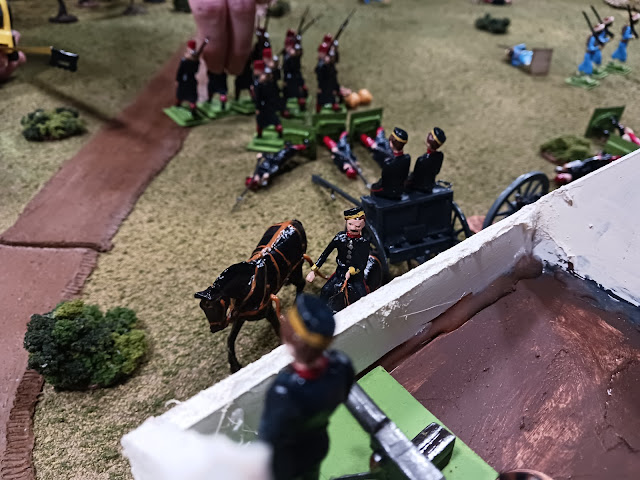 |
| The British in their initial deployments. |
I have been aware of the rules A Gentleman's War for many years now, but had not really thought about trying them until recently. I think this is because my 54mm armies simply were not at the necessary critical mass, and it so turns out that A Gentleman's War is very much written for a Belle Epoque army in a larger scale. So I grabbed a copy form Wargames Vault for $10. I will admit that on initial flipthrough I was not impressed - there were many charts for resolving shooting and close combat, which appears needlessly complicated at first glimpse. But while on Spring Break vacation I read the book cover to cover and came away much more impressed.
 |
| British starting positions, on the right. |
Once back, I roped old opponent Jamie into a game. We used my random terrain tiles to set up the game and deployed a generic scenario. Jamie played the French, and I the British. Jamie arranged two units of French infantry into an oversized attack column, with two half-units of tirailleurs to each side of the column. He also placed all his artillery on his right flank. I piled a lot of infantry into the walled village, but indecisively spread everything else out across the table.
 |
| French starting positions, on the left. |
The game was perhaps overlong, as we spent a lot of time trying to get the rules right.
 |
| British light infantry - the Kings Royal Rifles. |
The general flow was that some tirailleurs
were able to chase off the crew of the British field artillery on the
far British right, although these were subsequently over powered by a
flank charge from British regulars.
The French attack column was able to use Aces to good effect and closed with British regulars quickly and overpowered them. It then wheeled to its right and closed with another British regular unit.
By this time, though, the British had organized themselves a bit and
finally brought a lot of fire to bear on the column, sending it running
back towards its own center. Also around this time, the "What Luck, Chaps!" cards dropped a rainstorm on the battle - half movement and all ranges counting as two bands further!
On the opposite flank, the French artillery had been faring poorly trying to chase off the British light infantry. They fared even worse when rain ruined the visibility!
 |
| These Worchestershires drove off the tirailleurs who had driven off the field artillery, but then spent several card turns moving an inch or two in the mud at a time. |
Eventually the rain subsided (back to regular ranges but still half movement), but before anything else could happen, we drew the Fog event card, which again halved movement! It was already almost 10:00 pm, but we agreed to call the game on account of bad weather (!).
 |
| These are the remnants of the French attack column. |
 |
| French fire trying to chase of pesky light infantry. |
 |
| A lot of carnage in the British center... |
We then spent some time counting total figures lost to determine an actual percentage of starting forces lost for each side. Turned out the French fared a little worse, but their situation was clearly more favorable. If I have one complaint its that a more concrete end game mechanic would be nice. The old "first side to lose half breaks and runs away" is not a favorite. Still, its an easy fix and I have no complaints about the rest of the rule, which are an excellent fit for the Belle Epoque period.
The name Lisette en Croute was issued by Jamie. He tells me its a sort of French equivalent to a British village being named Samdgley-On-Broclishfire.

























I tend to end the game when a certain number of jokers have been drawn 4 for a quick game or 6 for a longer one.
ReplyDeleteEnding game on 4th joker sounds like a great idea!
DeleteGreat game and effort, thank you for sharing. Toy soldiers is timeless. Quinn
ReplyDelete